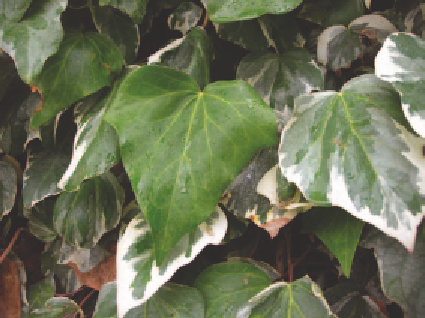Agriculture Reference
In-Depth Information
applies in the removal of old wood. Prune
back older wood to a strong side shoot
heading in the direction you want it to grow
in, or remove old stems altogether if there is
evidence of strong younger growth
clamouring for space. It must be noted that
many shrubs that produce autumn fruit can
also become environmental weeds. Always
choose what species you plant carefully, for
example,
Cotoneaster
spp. Your local council
will have a list of pest plant species.
coloured and variegated leaves are actually a
less efficient leaf than a plain green one.
Variegated leaves have less green parts that
absorb light (see page 5) due to the presence
of the variegation. For this reason a variegated
plant will often revert to the leaf colour of the
(a)
Variegated and coloured foliage plants
Shrubs with variegated foliage add a bit of
sparkle to the garden scene and can balance a
landscape reliant on flowers alone. They act
as a foil for the more glamourous members of
the landscape and are often the most
spectacular plants in winter when there is
little else to attract the eye.
(b)
Variegated and highly coloured plants are
selected chance seedlings or sports and as such
are not typical of the species from which they
derive. In fact, they are an aberration. Highly
Figure 4.12
When variegated plants are grown in low
light conditions, the leaves can revert. Ivy may be a
shade-tolerant plant, but variegations are not (a). Black
and highly coloured leaves are an aberration just like
variegations. In the centre of this plant, deprived of light
the leaves are green-not the black that has access to the
light (b).
Figure 4.11
When variegated plants are stressed, they
will often revert to the original green colour of the
species. Remove all such parts, just behind the next
variegated bud.



